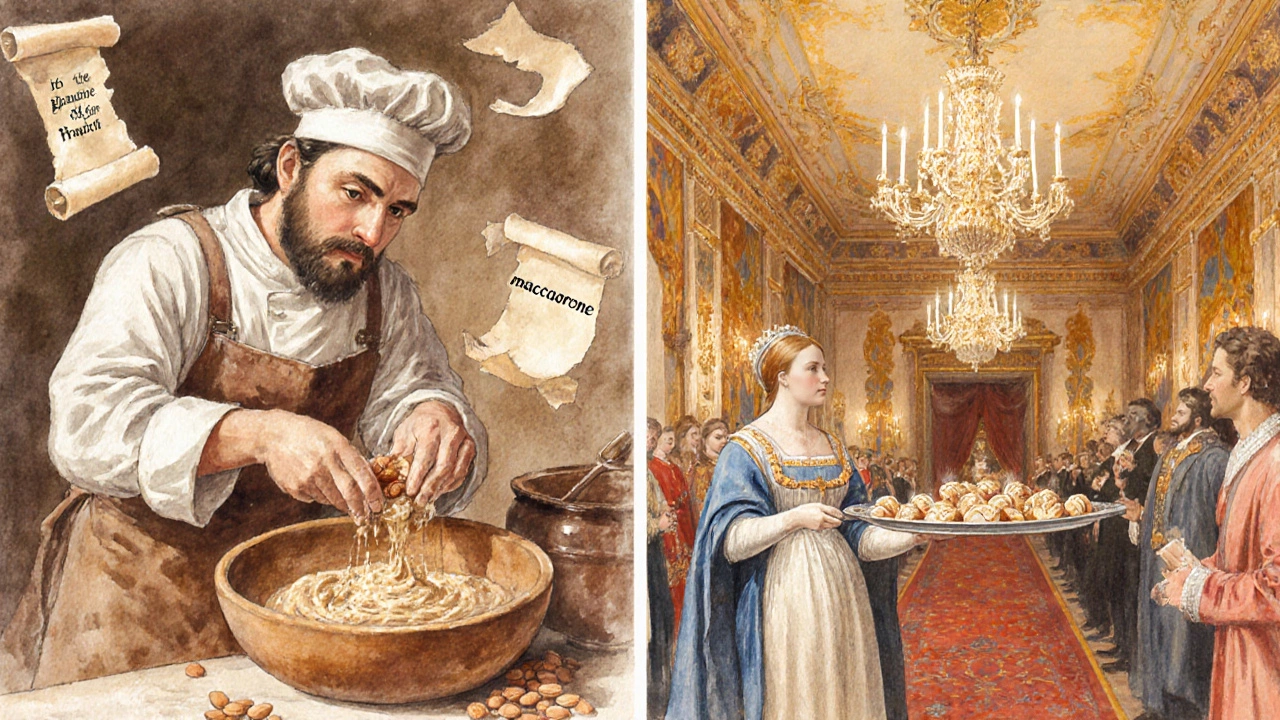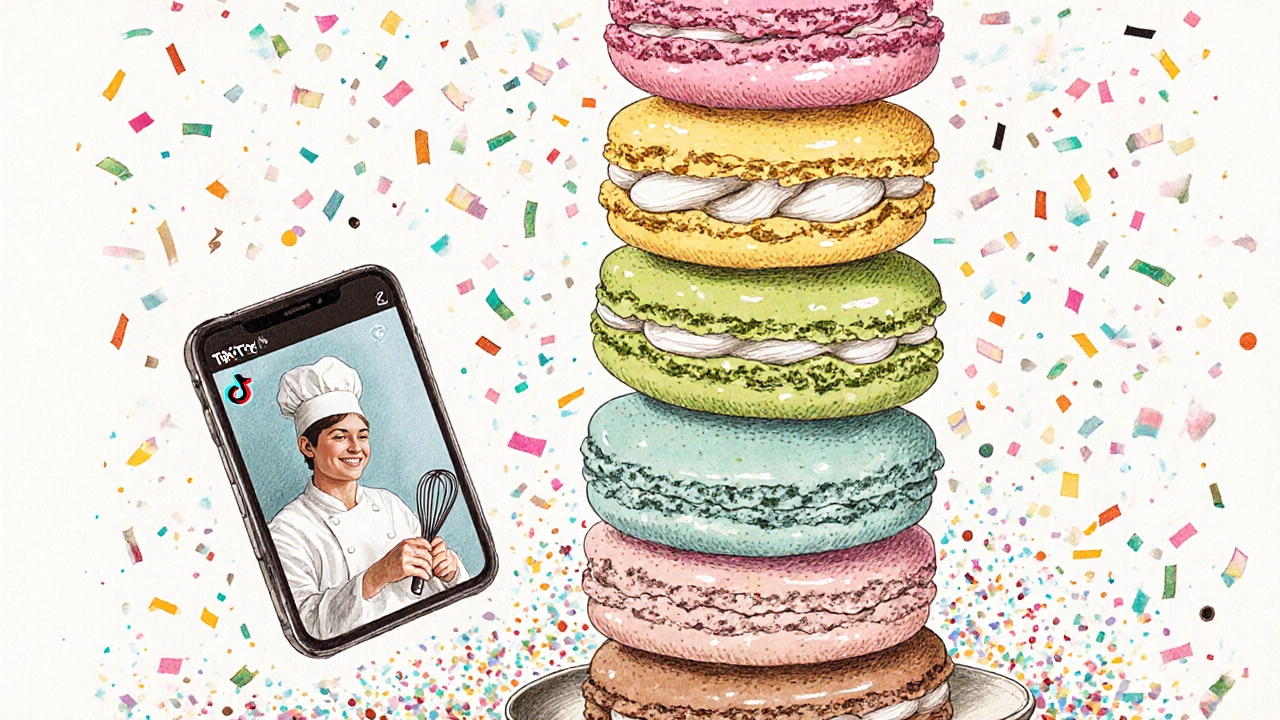Macaron vs. Macaroon Comparison Tool
Macaron vs. Macaroon Comparison
| Category | French Macaron | Coconut Macaroon |
|---|
Note: This comparison is based on the article's content about traditional French macarons versus American coconut macaroons.
Macaron is a delicate French sandwich cookie made of two almond‑based meringue shells filled with ganache, buttercream, or jam. If you’ve ever wondered why the delicate treat is called macaron, the answer lies in centuries of linguistic twists, royal intrigue, and culinary innovation.
The Word ‘Macaron’ - A Quick Overview
At first glance, the name sounds French, but its roots travel far beyond the borders of Paris. Understanding the name helps you appreciate the cookie’s journey from a medieval almond paste to the Instagram‑famous bite we see today.
Etymology: From ‘Maccarone’ to ‘Macaron’
The earliest traceable form of the word appears in 16th‑century Italian cookbooks as maccarone or maccaroni. These terms described a paste of ground almonds mixed with honey and egg whites - essentially the core of today’s macaron. When the recipe migrated north, the Italian word was Gallicized, shedding the final “e” and adopting the French spelling “macaron.”
Italian Roots and the Almond Connection
Almonds are the star ingredient that gave the macaron its name. In the original Italian version, the paste was called Almond the nut whose finely ground flesh forms the base of the cookie batter. The almond’s creamy texture and subtle flavor made it perfect for creating a light, airy confection that could be shaped into bite‑size shells.

The Catherine de’ Medici Legend
One popular story links the macaron’s French debut to Catherine de’ Medici, the Italian duchess who married King HenryII of France in 1533. According to the legend, Catherine brought her beloved almond sweets to the French court, where they evolved into the modern macaron. While the tale adds romantic flair, historians note that the term “macaron” didn’t appear in French culinary texts until the early 1700s, well after her death.
How the French Refined the Cookie
In the 18th century, Parisian pastry chefs began perfecting the technique of folding almond flour into whipped egg whites - a method known as Meringue a whipped mixture of egg whites and sugar that gives the macaron its characteristic rise and glossy crust. The result was a lighter, crisper shell that could be sandwiched with a variety of fillings.
By the late 1800s, the famous pastry shop Ladurée started offering macrons (the original spelling) in pastel colors, cementing the cookie’s status as a French luxury treat.
Key Ingredients That Shape Its Identity
- Almond Flour finely ground almonds that provide flavor and structure
- Egg whites - the foundation of the meringue
- Granulated sugar - sweetens and stabilizes the meringue
- Powdered sugar - helps achieve a smooth batter
- Filling - ranging from classic buttercream to exotic matcha ganache
Each component plays a specific role. Too much almond flour can make the shells dense; too little, and they won’t hold together. Mastering the ratio (about 1part almond flour to 1part powdered sugar) is the secret behind a perfect macaron.

Macaron vs. Coconut Macaroon - Spot the Difference
Many people confuse the French macaron with the American coconut macaroon. While the names sound alike, the two cookies are fundamentally different.
| Attribute | French Macaron | Coconut Macaroon |
|---|---|---|
| Main Ingredient | Almond flour + meringue | Coconut shreds + egg whites |
| Texture | Soft interior, crisp shell | Chewy, dense |
| Origin | France (19thcentury) | Italy/USA (early 20thcentury) |
| Typical Shape | Round sandwich (2 shells) | Round cluster or individual bite |
| Common Fillings | Ganache, buttercream, jam | Often plain or dipped in chocolate |
The confusion likely stems from the similar spelling and the fact that both are almond‑based (or at least nut‑based) treats. Remember: the French macaron is a delicate sandwich cookie; the coconut macaroon is a hearty, chewy morsel.
Modern Variations and Global Craze
Today, chefs like Pierre Hermé renowned French pastry chef known for inventing the "Ispahan" macaron flavor push the boundaries with flavors such as rose‑lychee, salted caramel, and matcha. In 2024, TikTok videos of pastel‑colored macaron towers generated millions of views, turning the cookie into a social‑media icon.
Even vegans can enjoy a macaron, swapping egg whites for aquafaba (the liquid from canned chickpeas) while keeping the almond base. Gluten‑free bakers appreciate that the traditional recipe is naturally free of gluten, making it a safe choice for many dietary restrictions.
Frequently Asked Questions
Why is the French cookie called "macaron" and not "macaroon"?
The name derives from the Italian word maccarone, referring to an almond paste. When the recipe moved to France, the spelling shifted to "macaron" to match French phonetics. "Macaroon" refers to a different coconut‑based cookie that evolved separately.
Did Catherine de’ Medici really introduce macrons to France?
The story is popular but not historically verified. Catherine did bring Italian culinary ideas to the French court, yet the term "macaron" only appears in French records decades after her death, suggesting the legend is more myth than fact.
What is the key difference between a macaron and a macaroon?
A French macaron is a sandwich cookie made with almond flour and meringue, resulting in a crisp‑soft texture. A coconut macaroon is a dense, chewy cookie made primarily from shredded coconut and egg whites.
Can I make macrons without eggs?
Yes. Using aquafaba (the liquid from canned chickpeas) as a substitute for egg whites can create a vegan-friendly meringue. The texture may be slightly different, but with proper ratios you can achieve a comparable rise.
Why do macrons have a "foot" at the bottom?
The foot forms when the batter spreads slightly during baking, creating a raised base. It indicates the shells were properly aerated and rested before entering the oven.